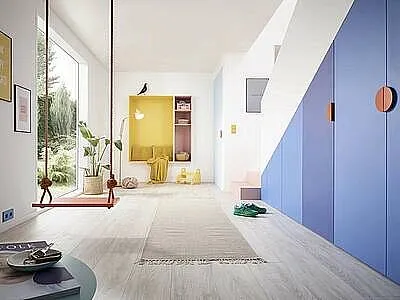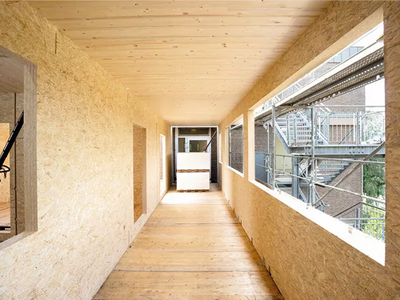Frequently Asked Questions
Installation
Swiss Krono USA flooring, like all laminate flooring, is made from a high-density fiberboard core that will shrink or swell depending on its temperature and surrounding humidity. Because these conditions vary greatly from the inside of a store or warehouse to your home, planks need time to acclimate so that they will fit properly, preventing gaps or buckling. This should be done by laying each box flat, side-by-side, for at least 48 hours in the center of the room in which they will be installed.
Laminate flooring and basements are made for each other, provided the environment has the right conditions. Here are the conditions in which Swiss Krono laminate flooring can be installed:
- The space is below grade with at least one concrete wall;
- The concrete-slab floor must have been poured with a poly sheet underneath it. This helps protect against changes in hydrostatic pressure and controls the curing process;
- The concrete-slab floor must be more than 90 days old (so that it’s adequately cured);
- It can have a “walk-out” onto a patio area or walkway; and
- It cannot have a drain in the floor or a French drain along the inside of the perimeter of the floor. If it does, we don’t recommend a laminate floor.
The answer is a qualified “yes,” unless the existing floor is hardwood; then the answer is an unqualified “no.” If the existing floor is vinyl (as is pretty common), approach the installation as if it were a bare concrete floor:
Install a vapor barrier (more about that below) and cushion pad (unless your laminate plank already has an attached pad). Don’t assume the floor is level or flat enough for a successful laminate-floor installation. And remember: Never install laminate flooring over any type of carpet.
Always use a vapor barrier, which is the plastic film between the concrete-slab floor and your padding and laminate plank. Swiss Krono specifies that the vapor barrier for its laminate floors must be 6mm thick and made of virgin polyester. Recycled film may not have the structural integrity you need. Remember, below grade concrete walls are subject to hydrostatic pressure, too, therefore run the vapor barrier up the concrete wall about 4 inches in order to protect the exposed edge of planks next to it. Even with an expansion gap between the plank and the wall, the exposed edge could use the extra protection. A bead of 100% mildew-resistant silicone sealant would also be a good idea. After you’ve installed the baseboard, just cut away any excess vapor barrier showing above it.
Do not run the vapor barrier up a non-concrete wall such as a drywall surface, 2-by-4 inch framing, or wood or vinyl veneer.
When it comes to laminate flooring, we would say “no” in most cases because the moisture-abatement product must have zero VOCs (Volatile Organic Compounds) to be acceptable underneath a Swiss Krono laminate floor. VOCs are the off-gassing of chemical compounds used in the manufacture of many household items, from paints and varnishes to wood products. Because the melamine backing on Swiss Krono laminate planks is so impermeable, the VOC gases produced by most moisture-abatement coatings will have nowhere to go. Trapped gas will build-up under the vapor barrier of the floor and, over time, will cause the floor to “pillow.”
You can start installing your floor against any wall, but some are better than others. Typically you want to run your laminate parallel to the main light source to decrease the visibility of the seam across the length of the product. In order to accomplish this, you would need to start on the wall either to the left or the right of your main light source. If there is not a large window or main light source, we recommend starting against the longest wall. If all your doors are located on one wall, it may be easier to start on that wall so that you can slide your laminate underneath the door jams. You will want to start on the left side of the wall you pick with the tongue on the long side of a plank facing the wall, removing the tongue before installing the plank. (You can use a sharp utility knife for the 7mm or 8mm product, but our 10mm or 12mm planks will require a saw.) It’s important to work from left to right to avoid damaging the tongues on the short side of the boards. We recommend installing the first and second row at the same time to ensure that everything is square. Basically, you’ll be using the second row to line up the first row before tapping the end joints together.
It is very important to keep the tongue and groove along the plank clean of any debris, including its corners. Be sure to check those carefully. We recommend using a soft-bristle brush frequently during installation to remove debris from the locking system. Chips also can result from improper tapping tools or techniques, improper acclimation, or concealed shipping damage not discovered during installation.
Do not install any planks with visual defects. Instead, use chipped boards for cut planks along the left and right walls. Use planks with damage to the grooved end along the right wall and planks with damage to the tongued end along the left wall, making sure the chipped parts will be hidden underneath the quarter-round or base molding.
The vapor barrier should extend 2 to 4 inches up each wall and folded or cut back after the planks are installed to fit behind the wall’s base molding. This creates a tub effect and prevents moisture from wicking from the concrete wall into the side of the floor planks.
Please avoid extreme variations in temperature and humidity. The ideal room temperature is between 64°F and 94°F, and the humidity should not exceed 75%.
Installation should take place at room temperature of at least 64°F. The following climatic conditions in the room must be ensured before, during and for at least three days after installation:
- Floor surface should be a minimum of 59°F.
- Room temperature should be a minimum of 64°F.
- Room humidity should be a minimum of 35 % and a maximum of 75%.
Before opening the packaging, acclimatize planks for 48 hours by laying each box flat, side-by-side, in the center of the room in which they are to be installed.
You should always use underlayment padding above the vapor barrier and below the laminate flooring planks. If a pad is already attached to the planks, no additional underlayment should be used.
If a pad is not part of the planking, a 3/8-inch cork underlayment is a premium underlayment and can be used to help meet the required sound standards in such homes as condominiums and apartments. The cost can run as much as $3 a square foot.
Note that density can be directly related to performance. Therefore, we recommend that you purchase cork underlayment supplied by US Floors, Natural Floors or National Cork. Products from QEP may or may not consistently meet our preferred density requirement for maximum performance.
Use a high-tooth-count fiber-tip saw blade. Remember that the “grill” — or the teeth of the blade — should come into contact with the décor face of the plank first.This will reduce chipping.
Chipping is not as big an issue in this case, however, because anytime you cut our planks you have removed the locking system so the cut edge will be toward the wall and covered by the quarter-round. Do not use pieces that are less than 16 inches in length.
Safety requirements:
- Wear a dust mask and safety glasses when cutting planks.
- Cut planks outside.
- Professional installers may use a dustless cutter that can be used inside.
You won’t be able to look the new planks directly into the existing floor but you’ll be able to “connect” the existing floor with your new floor by installing a transition profile between both.
This technique allows work on several rows at the same time in a stair-step fashion, the first row longer than the next and so on. This is done by professional installers because it allows more than one person to work on the floor simultaneously to finish the job quickly.
The do-it-yourselfer does not need a helper to lock a long row to the preceding row, but the advantages of both are:
1. Only handling cut pieces once to cut then installing them directly into the floor saves time and effort
2. Heavy furniture does NOT have to be moved out of the room.
Over time, this technique potentially could perform better as end joints remain locked to a tighter tolerance than those engaged without tapping.
Leave a minimum of 3/8-inch clearance around all sides of the room.
Before you install planks in front of an exterior doorway, be sure to shave away the locking system from the side that will face the exterior door. That piece will be on the edge of the floor exposed to extreme conditions. The gap between the exterior entrance and your first piece of laminate flooring should be filled with 100% silicone sealant to protect the flooring from moisture. We do not recommend having an end joint directly in the traffic path, however sometimes it may unavoidable.
For aesthetic reasons, we suggest cutting the laminate planks using a saw specially designed for door jams available at any hardware or home-improvement store. Once cut, install the laminate underneath the door jams.
You also may want to use a small bead of glue on the tongue of the locking system of those planks in the entrance area. Also consider using a door mat to help protect heavy-traffic entrances against snow, water and other debris that may be dragged in on shoes.
Check your local building code for the recommended distance. If no building code exists, leave at least 2 feet between the fireplace (or wood stove) and your laminate floor.
Depending on the product you purchased, the installation instructions are printed inside the box or on a separate slip sheet packed inside the box. You also can find installation instructions on this site, by visiting and selecting the locking system appropriate for the Swiss Krono laminate product you purchased.
Laminate flooring can be installed under your refrigerator but should not be installed under any stationary or extremely heavy furniture as this would prevent the flooring from expanding and contracting.
Lay planks around the island, leaving an expansion gap of 3/8-inch between it and the flooring. We also recommend adding glue to all four sides of each plank before installing the flooring around your sink, refrigerator and any other areas where water may occasionally be present. All expansion spaces in these areas must be filled with a 100% mildew-resistant silicone sealant. This will help you prevent damage from the presence of occasional moisture.
You do not have to remove the wall-base molding. Simply shave equal parts of the locking system off the top of the groove of the installed plank and the bottom of the tongue of the new plank and glue the long joint. Slide the last piece under the wall base and it will not have to lock to the second-to -last piece since you’ve shaved the tongue and groove down. Be sure to leave an expansion gap of at least 3/8 of an inch between the wall behind the wall base and the flooring. Read more below about how narrow that last plank can be.
Swiss Krono must be installed over a subfloor that is clean, smooth and level. Laminate flooring with attached underlayment padding can accept a deviance of 1/8 of an inch to over 40 inches, but any low spots of 3/16 of an inch or greater must be filled in with leveling compound.
Portland cement-based leveling compound is mixed with water then “floated” on the subfloor where it will flow to the low spots and level the floor. This leveling compound should dry within a few hours.
Conditional yes; the subfloor must be clean, smooth and level within our stated tolerance. Older mobile homes may not have a vapor barrier, you may have to pull the skirt to access under the structure to check and install a vapor barrier. If there’s a dirt crawl space underneath your mobile home you should cover it with plastic to keep moisture from rising up.
A double-wide can be wider than 25 feet. Please remember to use a transition molding, or T-molding, at every 40 feet in length and 25 feet in width.
Yes, a moisture test is strongly recommended when installing laminate flooring over concrete.
There are some DIY moisture-test kits available at home-improvement stores. If a less-than-favorable reading is returned it may be necessary to do a more precise test, like a calcium-chloride test, or use a meter specially designed to read moisture levels in concrete. The highest acceptable reading for a calcium-chloride test is 3 pounds over 24 hours for each 1,000 square feet; for a Tramex moisture meter, it is a reading of 4.5% or less.
If you’re having the floor professionally installed, your installer should have access to either one of these tests. Ask to see the test results and get a copy for your records.
Measuring for the molding pieces you will need is a lot easier than you may think. Measure for wall base and quarter-round first. Simply measure each wall and then total them up for the number of “running feet.” Add to that about 10% to cover waste. Once you have the total running feet you need, divide it by the length that the molding is sold in. You can do the math either in inches or feet. For example, if you came up with a total of 960 inches or 80 feet, and the molding is sold in 96-inch or 8-foot lengths, you would need 10 pieces of molding. If you don’t end up with an even number of lengths, it is always recommended that you round up to the next full length of molding. When it comes to transition-type molding, or T-molding, it’s a little different.
You will need to measure each doorway or opening between rooms. As a rule of thumb, one piece of T-molding will usually accommodate two doorways as long as the doorways are narrower than 36 inches. Because room temperature and humidity may vary from room to room, there can be different amounts of expansion and contraction. The transition (T-molding) in the doorway will prevent the floor from buckling. Also, if you have an opening that is wider than one piece of molding, we recommend that you split the T-molding in the center. You may have a little bit more waste doing it this way, but it will look better with the seam being in the middle.
Please remember to use T-molding in rooms measuring more than 40 feet so that dimensions don’t exceed 25 feet x 40 feet in any section.
Planks that are from 10mm to 12mm thick can be moved up to three times. The flooring should be removed carefully by taking each complete row apart along the long edge of the plank first and then separating the individual planks from each other on the short edge. It makes it easier to slightly raise the planks from the underside and place a hand under the short end connections. Lift the short edge until the two planks separate.
The narrowest piece must be 2.5 inches wide, or about as wide as one strip on a three-strip décor plank.
Please measure the net width of the room, deduct the space needed for expansion gaps on both sides, and divide it by the width of the planks. This will give you the total number of rows of planks for your project. If you come up with an uneven number of rows, remember that planks you cut lengthwise must be at least one-third of a plank or 2.5 inches wide.
Example: The net width of room is 96 inches, minus 2 x 3/8 inches (for the expansion gap), divided by 7.6 inches (plank width), which equals 12.53 planks. If you do not have at least .33 as a remainder, you must also rip the first row along the starting wall so the width of the last row against the finishing wall is at least 2.5 inches.
The 2.5-inch minimum-width for the plank accommodates the weight of heavy furniture that generally sits along the walls.
Please allow a minimum of:
- 3 days after dry-wall installation and initial painting as they add a lot of humidity into the room
- 60 days for new concrete slab to cure.
Also remember that Swiss Krono flooring must be installed in a climate-controlled building with continuous HVAC operating.
The majority of our floors require the use of a pull bar. A good rule to go by is that if your floor requires the use of a tapping block then you are going to need a pull bar. Pull bars are used for the last plank in a row that ends at a vertical structure such as a wall. In these areas it is impossible to use a tapping block because space is limited; a pull bar is used instead. See below for pictures showing the how a pull bar is used, expansion requirements, and the smallest piece of planking you can use.
Square footage is the length of a floor multiplied by its width. If doing more than room, or if you have an irregularly shaped area, break it into smaller rectangles and add them together to get your total. If installing a wood-grain finish, we recommend you add 10% to your purchase to compensate for cuts and waste; add up to 20% more for tile patterns.
Remember to keep leftover planks or cartons in case a plank or section of the floor needs to be replaced in the future.
One of the advantages of Swiss Krono laminate flooring is its stain resistance. Therefore we do not recommend using any substances to alter its surface color or shine. Please consider some new pillows or a darker throw for your couch, an area rug, or different curtains to change your living room’s appearance.
Install the T-molding directly under the door when the door is fully closed.
No additional underlayment should be used because the product you purchased has an attached pad. Adding additional pad will void the warranty because the floor will have too much deflection, adding stress to the locking system that can cause it to fail over time. To answer your questions about specific surfaces:
- When installing over concrete a 6mm poly vapor barrier is required.
- Our product cannot be installed over carpet or a carpet pad, so these items must be removed prior to installation. This is for the same reason adding additional pad is not recommended.
- Laminate can be installed over sheet vinyl but it will require a 6mil vapor barrier if over a concrete subfloor.
- Laminate can be installed over existing hardwood floors that have been installed over a wooden subfloor without a vapor barrier. However, hardwood installed directly on top of a concrete floor must be removed prior to installing a laminate floor. This is because hardwood will not act as a vapor barrier, and putting the vapor barrier on top will trap moisture in the hardwood, causing it to mold and rot.
Depending on the product, each carton varies between 22 and 35 pounds.
It is not recommended to run wires or cables underneath your laminate for a couple of reasons: First, it may violate your local fire code; and second, it may cause unevenness in your subfloor that in turn will cause your laminate floor to buckle.
There are wire tracks available that enable you to install low-voltage wiring (for example: speaker wire, stereo cables, telephone wiring, network wiring or alarm wiring) behind standard wall-base molding. Some base moldings offer a channel for wiring as well.
SWISS KRONO offers AQUA ZERO waterproof floor panels , made on a hydrophobic green HDF board, which, in combination with a tight AQUA PEARL lock, allows the floor to withstand even three days of flooding. These panels are perfect for the hall, living room and even the kitchen.





